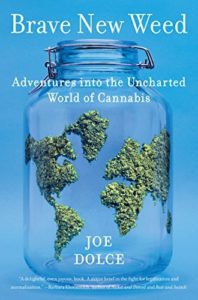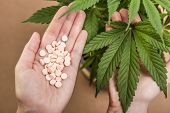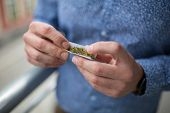 It’s Squib Saturday. Time to share the best, most interesting (or most entertaining, or most outrageous) tidbit of information I’ve gleaned from all the stuff I’ve read –or done– this week. Today: Brave New Weed – the perfect book gift for anyone who ever wanted to smoke a joint– and now lives in (or is visiting) a state where it’s legal.
It’s Squib Saturday. Time to share the best, most interesting (or most entertaining, or most outrageous) tidbit of information I’ve gleaned from all the stuff I’ve read –or done– this week. Today: Brave New Weed – the perfect book gift for anyone who ever wanted to smoke a joint– and now lives in (or is visiting) a state where it’s legal.
Joe Dolce, the author of this terrific tome, subtitled Adventures into the Uncharted World of Cannabis, begins by setting out the conundrum which has perplexed me (a Sixties flower child who once enjoyed hard liquor and tobacco) and those members of my generation who have for decades resisted lighting up a joint.
Namely: “If pot is as benign as its adherents claim, and such a miraculous and versatile medicine on top of that, how did it acquire such a bad rap?”
Treats Every Pain
 Dolce, a journalist and editor (and former editor-in-chief of the Star, a magazine where I also once toiled) has no problem presenting a footnoted and well-documented narrative which traces the history of the use and health benefits of cannabis going back 10,000 years.
Dolce, a journalist and editor (and former editor-in-chief of the Star, a magazine where I also once toiled) has no problem presenting a footnoted and well-documented narrative which traces the history of the use and health benefits of cannabis going back 10,000 years.
He also chronicles his interviews and observations from a trip to Israel where 20,000 persons are participating in the world’s largest state-run medical cannabis program. Twenty doctors can legally prescribe cannabis, and eight tightly monitored grows distribute it on-site, through home deliveries and in dispensaries and hospitals. At Tel Aviv’s Ichilov Hospital, Dolce spoke to Dr. Bereket Schiff-Keren, a pain specialist who has prescribed cannabis to more than 1,500 patients. She told him: “Cannabis treats every pain.”
Even ‘Golden Years’ Pain
“Half of the people in their ‘golden years’ suffer joint or muscle pain,” she says in the book. “Fifteen hundred patients over ten years have taught me that cannabis is useful in most cases.”
Dolce also interviewed doctors and professors of neuroscience at UCLA and Ohio State University who told him that their studies in cell cultures and animal models have shown the medical benefits of anti-inflammatory THC ( the main cannabis ingredient) in inhibiting the growth of certain cancers and slowing degeneration in aging brains.
Not Lethal
So why does cannabis remain classified as a Schedule I (no medical benefit and potentially lethal) narcotic when, according to the National Institutes of Health and National Institute on Drug Abuse there were zero deaths from cannabis overdose between 2001 and 2014? A fact seemingly even more outrageous when opioid pain relievers and prescription drugs classified as schedule II or III drugs have caused thousands upon thousands of overdose deaths during the same period.
Fear & Confusion
Dolce’s short answer is: “80 years of propaganda, woolly science and high moral dudgeon […] The government has succeeded magnificently sowing first fear and then confusion… by issuing claims unsupported by evidence and twisting science to [its] own ends.” He references, as an example, a study commissioned by President Richard Nixon in 1971 on the dangers of marijuana.
War on Pot
The final report based on the study, was four thousand pages long, and is considered the most comprehensive study of cannabis in American history. It concluded that punishment for marijuana was more harmful than the drug itself; it recommended decriminalizing personal possession, and moving it from a Schedule I narcotic to Schedule III.
Nixon disavowed the findings, and ignored every recommendation, thus keeping the truth about cannabis from the American media and public.
Big Pharma Has Its Say
 Dolce also points to the fact that vocal anti-pot groups are supported and funded by disgusting, disgraceful, hypocritical (my words, not Dolce’s) Big Pharma. He writes: “the two largest corporate funders of these anti-legalization groups are Purdue Pharma and Abbott Laboratories, the makers of OxyContin and Vicodin –opioid painkillers which are the “most addictive drugs known to man.”
Dolce also points to the fact that vocal anti-pot groups are supported and funded by disgusting, disgraceful, hypocritical (my words, not Dolce’s) Big Pharma. He writes: “the two largest corporate funders of these anti-legalization groups are Purdue Pharma and Abbott Laboratories, the makers of OxyContin and Vicodin –opioid painkillers which are the “most addictive drugs known to man.”
Big Liquor, Too
Meanwhile, lobbying for urine-analysis companies which are a multibillion dollar industry built on “piss, paranoia and the fiction of a drug-free America” is supported by — ?
You guessed it: liquor companies like Jim Beam and Anheuser-Busch, among others.
Looking Forward
Dolce nevertheless allows himself to look forward to the time — coming soon hopefully — when this country goes beyond mere legalization of the “agreeable weed” and seriously begins exploring its wellness and therapeutic effects, and the “potential power of cannabinoids on artistic expression.” To this end he has provided , at the very conclusion of the book, a checklist of how to use cannabis in the 21st century.
Smoking a joint ( just one to begin with) in a state which has legalized the use of recreational pot is on my “bucket” list for 2017 –after I have finished the first draft of my third novel, and am ready to begin working on edits — so, I have noted the following Dolce pointers which make the most sense to me:
 Rules for A New Generation
Rules for A New Generation
- Pot is dose-dependent. Know/learn the dose that makes you happy.
- Get to know your terpenes (the smell molecules that determine the type of high you will experience)
- Smoke a puff or two; wait a couple of minutes and evaluate the direction things are heading since cannabis is “the mirror that magnifies” what’s already going on in your mind
- Do What You Know in an enhanced state. Save learning new activities for another time.
- With edibles, make some test runs, ingest a known, specified amount, wait one-two hours to evaluate.
Updates to Follow in 2017
Photo Credits: Top photo, and bottom two photos JanMika & InnerVisionPro with Bigstockphoto.com
When “WHEN THE WORLD WILL COME TO THEIR SENSES” STOLEN FROM THE RED LOBSTER. AND STOP MAKING MOVIES,TV PROGRAMS,ALL PROMOTING THE OK USE OF GUNS ?